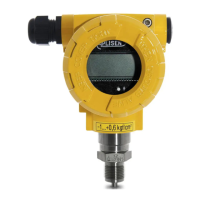E6 5 DTR.APC.APR.ALW.03(ENG)
Appendix Exd.ATEX
5.8. It is necessary to apply a shield cable or without shield cable with round cross-section in protection
from elastomer, not moisture absorbing, for example: YKSLY 2 * 1, YnTKSYekw 1 * 2 * 1, LIYCY 2 *
In case of need use cable with different structure, customer should co-ordinate this with transmitters’
manufacturer to choose intakes with cable diameter.
5.9. The general principles of connecting and the exploitation of transmitter in Exd realization should be
compatible with principles and relating standards for Exd casing devices how in p.2.1 Appendix
Exd.ATEX, in this including also: EN 600079-14, EN 60079-17.
5.10. During service must be made a check of the tight fastening of covers and the cable glands and
the fastening of the cable in the glands. The casing and supply line must be inspected for mechanical
damage, and the transmitter rating plate for legibility. Periodic checks should also be made of the
diaphragm, which should not carry signs of damage. During maintenance it is recommended that the
threads of the covers be lubricated with non-acid vaseline.
Because of the transmitter damage possibility, the ambient temperature should not be allowed
to become higher than 80ºC, even when there is no explosion risk.
6. The electrical connection way of transmitter’s series: APC-2000ALW/XX,
APR-2000ALW/XX, APR-2200ALW/XX, APR-2000GALW/XX
and APR-2000YALW/XX in Exd version
Fig. 2.
In case of transmitter calibration outside danger zone is possible communicator connecting to
<SIGNAL+> and <TEST+> terminals. Transmitter is furnished in communication resistor (R
D
= 240Ω),
closed with jumper at <SIGNAL-> and <TEST-> terminals installed by manufacturer. R
D
resistor can be
use then, when it is necessary to communicate with transmitter from its terminals and the load resistance
(Ro) in current loop is lover then 240Ω. Than <SIGNAL-> and <TEST-> terminals have to be open.
In danger zone don’t unscrew powered transmitter covers and don’t change the display position
or its back lighting.
Blocking cover method before unscrewing and plumbing possibility is shoved at Fig.21.
It is not permitted to repair or otherwise interfere with the transmitter’s electrical circuits in any
way. Damage estimation and repair possibility may be assessed by the manufacturer or another
authorized party only.

